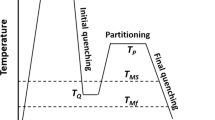Abstract
The straining electrode tensile test was employed to study hydrogen embrittlement in three grades of nickel. Aging at intermediate temperatures (400 to 800 °C) after solution annealing caused sulfur segregation to grain boundaries in the materials. This sulfur segregation was found to influence intergranular hydrogen embrittlement, and the effect was most prominent when the surface supply of hydrogen was low and when the grain boundaries were free of graphite precipitates. Aging also induced graphite precipitation at the grain boundaries of one grade of nickel (Nickel 200). The presence of these grain-boundary particles reduced susceptibility to hydrogen embrittlement, but at the same time caused a form of aging embrittlement. The effect of the second-phase precipitate, when present, masked the effect of sulfur segregation on hydrogen susceptibility.
Similar content being viewed by others
References
R. H. Jones: inAdvances in the Mechanics and Physics of Surfaces, R. M. Latanision and T. E. Fischer, eds., Harwood Academic Publishers, New York, NY, 1986, vol. 3, p. 1.
R.M. Latanision and H. Opperhauser, Jr.:Metall. Trans., 1974, vol. 5, p. 483;Metall. Trans. A, 1975, vol. 6A, p. 233.
M. Zamenzadeh, A. Allam, and H. W. Pickering:J. Electrochemical Soc, 1980, vol. 127, p. 1688.
M. E. Eberhart and R. M. Latanision: inModeling Environmental Effects on Crack Growth Processes, R. H. Jones and W. W. Gerberich, eds., TMS, Warrendale, PA, 1986, p. 125.
Ch. A. Wert:Hydrogen in Metals II, G. Alefeld and J. Volkl, eds., 1978, “Topics in Applied Physics,” vol. 29, p. 305.
A.W. Thompson and B.A. Wilcox:Scripta Metall., 1972, vol. 6, p. 689.
Huntington Alloys Bulletin 10M2-79T-15, Huntington Alloys, Inc., Huntington, WV, 1979.
Handbook of Auger Electron Spectroscopy, 2nd ed., Physical Elec- tronics Industries, Inc., Eden Prairie, MN, 1976.
S. Smialowska, C. Y. Chao, H. E. Chuang, and R.W. Staehle:J. Electrochem. Soc, 1979, vol. 126, p. 109.
E. E. Kunze and K. Schwabe:Corrosion, 1964, vol. 4, p. 109.
H. K. Birnbaum:Atomistics of Fracture, R. M. Latanision and J. R. Pickens, eds., Plenum Press, New York, NY, 1983, p. 733.
K.M. Olsen, CF. Larkin, and PH. Schmitt:Trans. ASM, 1961, vol. 53, p. 349.
A. W. Thompson:Grain Boundaries in Engineering Materials, J. L. Walter, K.J.H. Westbrook, and D. A. Woodford, eds., Claitor’s, Baton Rouge, LA, 1974.
L. Nanis:Environment-Sensitive Fracture of Engineering Materials, Z. A. Foroulis, ed., AIME, 1979, p. 361.
T. Asaoka, G. Lapasset, M. Auocouturier, and P. LaCombe:Corrosion, 1978, vol. 2, p. 39.
G. M. Pressouyre and I. M. Bernstein:Metall. Trans. A, 1978, vol. 9A, p. 1571.
W. M. Roberston:Metall. Trans. A, 1979, vol. 10A, p. 489.
Author information
Authors and Affiliations
Additional information
Formerly with Bell-Northern Research, Ottawa, ON, Canada.
Rights and permissions
About this article
Cite this article
Lee, T.S.F., Latanision, R.M. Effects of grain-boundary segregation and precipitation on the hydrogen susceptibility of nickel. Metall Trans A 18, 1653–1662 (1987). https://doi.org/10.1007/BF02646149
Received:
Issue Date:
DOI: https://doi.org/10.1007/BF02646149




